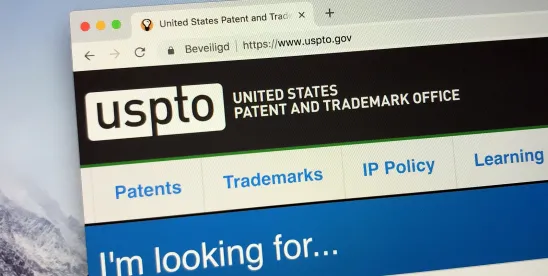The United States Patent and Trademark Office (USPTO) is facing vigorous backlash to its proposal to change terminal disclaimer practice used in patent applications and, not so subtly, discourage the use of continuation applications. On May 10, 2024, the USPTO issued a Notice of Proposed Rulemaking (NPRM) to add a new condition for a terminal disclaimer filed to obviate an obviousness-type double patenting (ODP) rejection. (89 FR 40439-01.) ODP rejections are based on “a judicially created doctrine grounded in public policy . . . primarily intended to prevent prolongation of a patent term by prohibiting claims in a second patent that are not patentably distinct from claims of a first patent.” (MPEP § 804.) Under the NPRM the applicant must agree that a patent subject to a terminal disclaimer would be unenforceable if a tribunal holds any claim of a patent tied by the terminal disclaimer invalid as anticipated or obvious, and all appeal rights have been exhausted.
Well over 90% of the public comments to date are strongly against the NPRM. Many commenters take issue with the new condition in a terminal disclaimer in which the applicant agrees that all claims of the terminally disclaimed patent will be rendered unenforceable upon a final holding from a tribunal that renders invalid a single claim in a patent tied to the terminally disclaimed patent. Other commenters contend that the NPRM runs against Federal Circuit precedent that the filing of a terminal disclaimer does not constitute an admission that the claims of the disclaimed patent are obvious. See, e.g., Quad Envtl. Techs. Corp. v. Union Sanitary Dist., 946 F.2d 870, 874 (Fed. Cir. 1991). Commenters also argue that the NPRM is a “substantive rule” that exceeds the rulemaking authority of the USPTO.
In a May 28 letter to USPTO Director Kathi Vidal, a group of five former USPTO Directors, Deputy Directors and Patent Commissioner took the unusual step of publicly opposing the NPRM. The former USPTO officials called on the USPTO to pull the NPRM immediately, arguing that the “proposed rules provide perverse incentives and threaten serious harm to America’s innovation economy.” They also argue that the NPRM runs “counter to decades of patent practice, undermining long-settled expectations.”
For its part, the USPTO urges that “[t]his action is being taken to prevent multiple patents directed to obvious variants of an invention from potentially deterring competition.” (89 FR 40439-01.) “The proposed rule is intended to promote competition by lowering the cost of challenging groups of patents tied by terminal disclaimers.” (Id.) As stressed by one public comment from Garmin International, Inc., “we are often victimized by those who abuse continuation practice before the USPTO”, including those who wield “low-quality” continuation applications. (PTO-P-2024-0003-0001, posted on May 17, 2024.)
Today, when the USPTO issues an ODP rejection of claims in a pending application over claims of a reference patent or pending application, the applicant can argue against the merits of the ODP rejection, amend the claims to avoid the ODP rejection, or file a terminal disclaimer to obviate the rejection. Applicants often face an ODP rejection of claims in a continuation application over claims in the parent. In taking the terminal disclaimer route, the applicant pays a nominal $170 fee and agrees that the term of the disclaimed patent will not extend past the term of the reference patent or application. The applicant also agrees that the disclaimed patent is only enforceable so long as it remains commonly owned with the reference patent or application. Applicants often choose to file a terminal disclaimer as a relatively low-risk, cost-saving measure, especially since long-standing precedent holds that the mere filing of a terminal disclaimer does not constitute an admission of obviousness and the filing of the terminal disclaimer often does not result in any loss in patent term.
In contrast, the NPRM substantially changes the calculus for an applicant facing an ODP rejection. Foremost, the terminally disclaimed patent will be unenforceable once a tribunal finally holds a single claim in a patent tied directly or indirectly to the terminally disclaimed patent invalid over prior art. That is, the NPRM puts entire patent families with one or more terminal disclaimers at risk upon a holding of invalidity of a single claim in one patent in the family. As suggested by the USPTO, applicants can overcome an ODP rejection without filing a terminal disclaimer by moving claims subject to an ODP rejection into a parent application, if pending, or cancel the claims. Yet these options are only available in limited circumstances and/or may not be consistent with an applicant’s strategy. An applicant can also argue against the merits of the ODP rejection; however, the arguments are complex (see, e.g., MPEP § 804.02), may not be successful, and filing a terminal disclaimer later in prosecution may be substantially more expensive in the future (see 89 FR 23226 [proposing a fee of $800 for a terminal disclaimer filed after a Final Office Action]).
Ultimately, applicants likely will need to change their strategies for obtaining varying patent claim coverage to avoid the new risks presented by a filing a terminal disclaimer. For example, an applicant might be advised to limit its filing of continuation applications. An applicant can instead file a single application with substantially more claims of varying breadth. Having all claims in one application will reduce the likelihood of any ODP rejection and the need for filing a terminal disclaimer. Even if some of the claims are restricted and the applicant files a divisional application with the restricted claims, an Examiner would be statutorily barred from issuing an ODP rejection against the new claims. (See 35 U.S.C. § 121; MPEP § 804.01.) On the other hand, a strategy that limits the filing of continuation applications will likely increase cost. For example, an applicant will incur substantially more fees to file a single application with 6 independent claims and 40 claims than filing two continuation applications, each with 3 independent claims and 20 claims in total.
We will continue to monitor the status of the USPTO’s terminal disclaimer proposal and the public comments in response to it.






 />i
/>i

